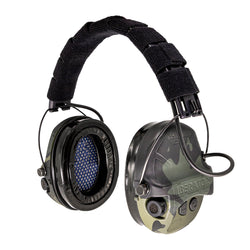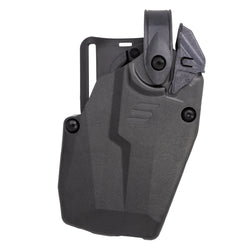If you’re an American citizen, you can obtain most Glock handguns. Heck, thanks to the Glock factory in Smyrna, Georgia, we can finally get some of the earlier .380s banned from import. Glock still hasn’t released the 46 in the United States, but the most desired and most difficult to obtain is the Glock 18.
The Glock 18 might be the holy grail for Glock collectors. It’s the rarest pistol and likely has the lowest production rate of any Glock pistol. The Glock 18 was Gaston Glock’s second pistol, first premiered in 1986.

It’s desirable, rare, and almost impossible to obtain because it’s a machine gun.
That’s the legal definition of a machine gun, not the military definition. More appropriately, it’s a machine pistol. Nonetheless, it’s full auto, and there are zero transferable Glock 18s. The few that exist require licensure from the Federal Government, a lot of paperwork, and a rigamarole to obtain.
Glock likely owns the majority of guns in the United States. The Glock 18 is a fascinating gun. Gun guys and gals know it, and pop culture exposed it to the masses. It’s a legendary gun, almost mythic due to its full-auto design and difficulty obtaining.
What’s the Glock 18?
The Glock 18 is a full-sized 9mm pistol capable of selective fire. Its slide features a fire selector. When the selector is pressed upward, the weapon fires in semi-auto mode, and when pressed down, it fires in full-auto mode.
The firing rate is absurdly high, which is common with machine pistols due to their short slide travel. The rate of fire is around 1,200 rounds per minute, but it may vary depending on the ammunition used. At 1200 rounds per minute, we are looking at 20 rounds per second.

Externally, it looks a lot like the Glock 17, Glock’s first pistol, and another full-sized 9mm pistol. The biggest difference to the naked eye is the fire selector. With that said, there aren’t a whole lot of interchangeable parts. The Glock 18 slide can’t fit on a Glock 17 frame, and vice versa.
Glock purposefully raised the rails on the Glock 18’s frame to prevent interchangeability. While they share magazines and likely some small parts, they are largely incompatible.
Glock still produces and sells the 18 to qualified customers. The firearm is displayed on Glock’s European website. It has entered its fourth Generation. Interestingly, the Glock 18 comes with a 19-round magazine that’s slightly longer than the 17’s 17-round magazine.
History of the Glock 18
Glock initially developed the 18 to test the components of Glock pistols. A machine pistol is a helluva testing tool if you’re testing for wear, heat resistance, and lifespan. Its high rate of fire makes it quick and easy to reach high round counts and subjects the gun to an amount of stress a semi-auto would never replicate.
The original Glock 18 featured a slightly longer barrel with porting, which was quickly discarded because it would not fit in Glock 17 holsters. Later, compensated models, labeled the G18C, were produced. These used ports in the barrel and slide to help resist the upward movement of the gun while firing.

The Austrian counterterrorism unit EKO Cobra (Sweet name, BTW) also requested machine pistols for its operations. It is unknown how exactly these guns were used or whether they were used extensively.
Beyond Austria
Machine pistols are very niche, and the Glock 18 has been adopted in limited numbers by Austria, Argentina, Armenia, Malaysia, and the Netherlands. In these countries, the gun is fielded by elite special operations or police forces.

Interestingly, as Steve Comus reported in the 1993 edition of The Gun Digest Book of 9mm Handguns, the Douglas County Sheriff’s Department purchased Glock 18s as an entry weapon during drug raids. That’s the only American adoption of the pistol I can find.
The most fascinating piece of Glock 18 trivia comes from Iraq. When coalition forces captured Saddam Hussein, he carried a Glock 18. How he came into possession of the gun is unknown. That Glock 18 was presented to George Bush, and it currently sits in the George H.W. Bush Library Center.
The Problem With Machine Pistols
Why didn’t the Glock 18 catch on like wildfire? Why wouldn’t you want a full-auto gun if that’s an option? Well, machine pistols aren’t the easiest guns to control.
Small, lightweight guns firing full auto can be very difficult to manage. People are shocked to find that even full-auto rifles are difficult to control, so imagine how hard a handgun firing 20 rounds per second can be.

It can be done, but it takes a lot of training and trigger control. Anytime you shoot, you’re responsible for every round you fire. It’s easy to miss, and even easier to miss, when you fire 10 rounds in half a second.
It’s a liability and unnecessary. Full auto fire is primarily a suppressive mechanism, and handguns don’t work well suppressing the target. The main niche would be close-quarters anti-ambush use, and that’s quite rare.
Glock 18 In Pop Culture
Part of the reason the Glock 18 is so famous isn’t due to its history or performance, but due to pop culture. It’s appeared in numerous video games and movies. Movies like Terminator 3, The Matrix Reloaded, and my personal favorite, Skyfall.

In Skyfall, a bad guy wields a Glock 18 fitted with a 100-round Beta drum. It’s absurd but eye-catching, and it’s the only way to fire for more than a few seconds before running empty.
Besides movies, it has been used in nearly every Tom Clancy first-person shooter. Terrorists and good guys can wield it in Counter-Strike and Escape From Tokarev, two games that are quite popular. Video games are where it seems like the Glock 18 excels, and the only chance most of us will have to handle one.
⚠️ The Glock Vault
This article is part of our comprehensive database. Jump directly to:
The Glock We Can’t Have
Between the NFA and the Hughes Amendment, it seems highly unlikely that the Glock 18 will ever be available for the average Joe. It’s locked behind a mountain of laws and bureaucracy. It’s a fascinating gun, and one desired not for its performance but simply because of its unique nature and unavailability.









